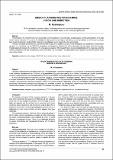| dc.contributor.author | Kashiripoor, Mohammad Mahdi | |
| dc.coverage.spatial | Brest | ru_RU |
| dc.date.accessioned | 2023-03-14T06:45:11Z | |
| dc.date.available | 2023-03-14T06:45:11Z | |
| dc.date.issued | 2022 | |
| dc.identifier.citation | Kashiripoor, M. M. Urban planning post-pandemics: vision and direction / M. M. Kashiripoor // Vestnik of Brest State Technical University. – Brest : BrSTU, 2022. – № 3. – P. 9–11. – Bibliography: p. 11 (3 titles). | ru_RU |
| dc.identifier.uri | https://rep.bstu.by/handle/data/32807 | |
| dc.description | Каширипур М. М. Градостроительство после пандемии: видение и направление | ru_RU |
| dc.description.abstract | The principles of the urban formation have always been built on socialization, the construction of public spaces and the systematization of the huge human masses’ interaction. Of course, in the formation of urban space there are objects that allowing you to feel solitude, but still the city has always been a place of interaction. But the COVID-19 pandemic has changed modern views of the urban environment. The article discusses the relevance of urban development in a pandemic situation. Examples of city development after pandemics in human history are given. It is considered how the COVID-19 coronavirus has changed the understanding of the organization of urban space and human housing. Possible options for changing the conditions of the urban area are analyzed. This research tries to review developed factors of the urban area under the influence of epidemics and their consequences, among which there may be changes in the organization of public spaces on a scale from specific urban are to global solution. | ru_RU |
| dc.language.iso | en | ru_RU |
| dc.publisher | BrSTU | ru_RU |
| dc.subject | пандемии | ru_RU |
| dc.subject | pandemics | ru_RU |
| dc.subject | градостроительство | ru_RU |
| dc.subject | urban design | ru_RU |
| dc.title | Urban planning post-pandemics: vision and direction | ru_RU |
| dc.title.alternative | Градостроительство после пандемии: видение и направление | ru_RU |
| dc.type | Статья (Article) | ru_RU |
| dc.identifier.udc | 711.435 | ru_RU |
| dc.abstract.alternative | Принципы градостроительства всегда строились на социализации, построении общественных пространств и систематизации взаимодействия огромных человеческих масс. Конечно, в формировании городского пространства есть объекты, позволяющие ощутить уединение, но все же город всегда был местом взаимодействия. Но пандемия COVID-19 изменила современные взгляды на городскую среду. В статье рассматривается актуальность развития городов в условиях пандемии. Приведены примеры развития городов после пандемий в истории человечества. Рассмотрено, как коронавирус COVID-19 изменил представления об организации городского пространства и жилья человека. Анализируются возможные варианты изменения условий городской территории. В данном исследовании предпринята попытка рассмотреть сложившиеся факторы городской среды под влиянием эпидемий и их последствий, среди которых могут быть изменения в организации общественных пространств в масштабе от конкретных городских до глобальных решений. | ru_RU |
| dc.identifier.doi | https://doi.org/10.36773/1818-1112-2022-129-3-9-11 | |
